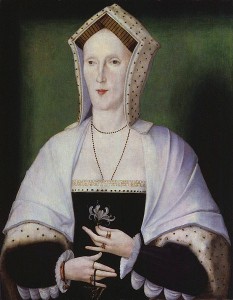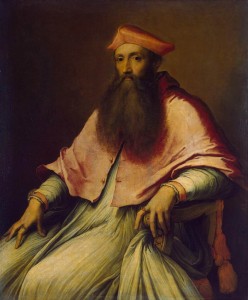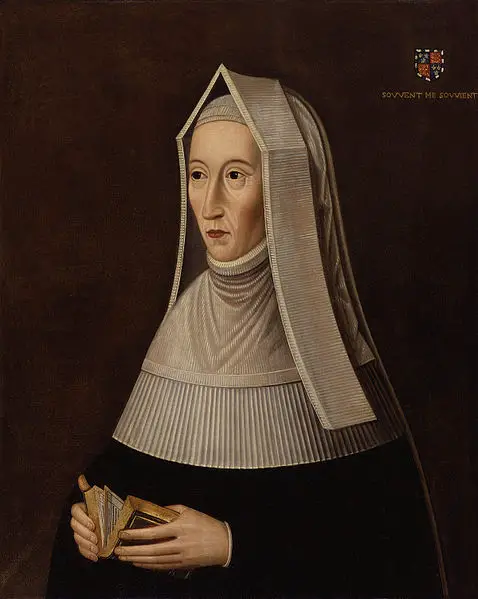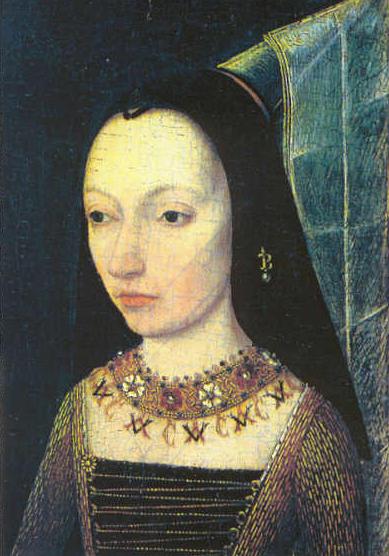 Margaret Pole, Countess of Salisbury, born on 14 August 1473, was the only surviving daughter of George, Duke of Clarence, and his wife, Isabel Neville. She was the niece of Edward IV and Richard III, and cousin of Elizabeth of York, Henry VII’s consort. Her brother, Edward, Earl of Warwick, was executed by Henry VII in 1499 in response to a request forwarded by the Spanish monarchs during the marital negotiations between Arthur, Prince of Wales, and Katherine of Aragon, since they feared that Warwick’s presence would encourage rebellion against the Tudor dynasty.
Margaret Pole, Countess of Salisbury, born on 14 August 1473, was the only surviving daughter of George, Duke of Clarence, and his wife, Isabel Neville. She was the niece of Edward IV and Richard III, and cousin of Elizabeth of York, Henry VII’s consort. Her brother, Edward, Earl of Warwick, was executed by Henry VII in 1499 in response to a request forwarded by the Spanish monarchs during the marital negotiations between Arthur, Prince of Wales, and Katherine of Aragon, since they feared that Warwick’s presence would encourage rebellion against the Tudor dynasty.
Perhaps in 1487, when she was fourteen, Margaret married Sir Richard Pole, a disparaging marital alliance from her perspective in view of her royal blood. Richard was later made an esquire of the body, chamberlain of North Wales, chamberlain of Chester and a member of the council in the Welsh Marches. In 1493, he was appointed chamberlain to the king’s son, Arthur, whose household was established at Ludlow that year. In 1499, he was elected to the Order of the Garter and participated at the proxy wedding of Arthur to Katherine. In 1504, Richard died, and Margaret was granted a generous loan to ensure that her husband’s funeral would be appropriately honourable. When not at court, she seems to have resided primarily at Warblington Castle and Bisham Manor. With Richard, she had five children: Henry, Arthur, Reginald, Geoffrey and Ursula.
In 1501, Margaret briefly served in the household of Katherine of Aragon, an appointment that enabled her to develop a close friendship with the Spanish princess. After her husband’s death, however, Margaret’s financial situation gave her cause for concern, since her jointure provided her with an insufficient income. As a result, she decided to entrust her son Reginald to the church. Henry VIII’s accession in 1509 improved Margaret’s fortunes, for she was appointed as an attendant to Queen Katherine of Aragon and, three years later, was restored to the earldom of Salisbury and the lands that had been held by her brother at the time of his execution. As countess, Margaret held estates in seventeen counties, mainly in the south and midlands, as well as lands in Wales and Calais. The countess was chiefly occupied with her role as patron of humanist scholars, as well as in her activities as a landlord. Margaret also concerned herself with the upbringing of her children. In 1514, her son Arthur accompanied the king’s sister Mary to France for her marriage to Louis XII; Arthur was later made an esquire of the body and a gentleman of the privy chamber. In 1518, Margaret’s only daughter, Ursula, made a respectable marriage to Henry Stafford, son and heir of the executed Duke of Buckingham.
However, at about this time several of Margaret’s lands were repossessed by the crown, an act that Margaret did not take kindly to. Although she was appointed governess to Princess Mary in 1520, she was deprived of her office the following year after her sons came under suspicion for involvement in the Duke of Buckingham’s treasonous activity. She was restored to the position of governess in 1525.
Margaret responded negatively to Henry VIII’s decision to annul his marriage to Katherine, and in 1533 refused to surrender Mary’s jewels and plate. Reginald Pole’s hostility to the king, moreover, further complicated Margaret’s life. Although she openly admonished Reginald in a letter that was probably intended to be seen by the king’s council, it did not greatly improve her situation. The circumstances worsened in 1538 when her third son, Geoffrey, was arrested on the grounds of communicating with Reginald, viewed by the king as a traitor. Margaret and her family were implicated, and at the end of that year, the countess was interrogated by the Earl of Southampton and the Bishop of Ely. She firmly denied that she had been involved in any treasonous activity. Despite her calm demeanour and denial of treason, the countess was later incarcerated in the Tower of London, having been attainted on the grounds of aiding and abetting her sons Henry and Reginald. In January 1539, Henry Pole and the Marquess of Exeter were executed. On 27 May 1541, the countess herself was beheaded, perhaps in response to her alleged involvement in the suspected association between Thomas Wyatt and John Wallop with Reginald Pole. The king also seems to have desired the Tower to have been emptied of its prisoners before he set out on his royal progress to the north of England. After hearing of her death, Reginald commented that he was proud to be the son of a martyr.The countess was buried in the chapel of St Peter ad Vincula, and in 1886 she was beatified by Pope Leo XIII.
Written by Conor Byrne, author of Katherine Howard: A New History and Queenship in England: 1308–1485 Gender and Power in the Late Middle Ages. Conor is a British graduate with a degree in History from the University of Exeter. Conor has been fascinated by the Tudors, medieval and early modern history from the age of eleven, particularly the lives of European kings and queens. His research into Katherine Howard, fifth consort of Henry VIII of England, began in 2011-12, and his first extended essay on her, related to the subject of her downfall in 1541-2, was written for an Oxford University competition. Since then Conor has embarked on a full-length study of queen Katharine's career, encompassing original research and drawing on extended reading into sixteenth-century gender, sexuality and honour. Some of the conclusions reached are controversial and likely to spark considerable debate, but Conor hopes for a thorough reassessment of Katherine Howard's life. Conor runs a historical blog which explores a diverse range of historical topics and issues. He is also interested in modern European, Russian, and African history, and, more broadly, researches the lives of medieval queens, including current research into the defamed 'she-wolf' bride of Edward II, Isabella of France.
Conor is currently studying for a Masters.




The story of Margaret Pole is one of the fascinating in history and she is one of my favourite people. Her story spans four reigns, Edward iv, Richard iii, Henry Vii and Henry viii. She was the last great matriarch of the Plantagenet and Tudor worlds and better claims to the throne than Elizabeth ii exist because of the survival of some of her children and grandchildren. Margaret Plantagenet or Margaret of Clarence was in line for the crown, failing her brother or Edward iv’s children, as the daughter of George Duke of Clarence, middle brother of Richard iii and Edward iv. Her mother was the elder daughter of the rich and powerful, Richard, Earl of Warwick, Isabella Neville.
Unfortunately for both Margaret and her brother, Edward (too many people with the same name) their father was a right twit who rebelled three times against his elder brother before going too far. During the Summer of 1477 he first of all boasted that his brother was not lawfully married or begotten, spread rumours he was the true heir and then caused trouble about the court. This followed the normal pattern of his behaviour, but what he did next pushed Edward iv over the edge. His wife died from complications of childbirth but George believed she had been poisoned. George accused the midwife and her husband of witchcraft and murder. Edward did nothing so he had them both hung. When taken to task he began to make more accusations and put Edward’s children at risk. He was tried, with the King as prosecutor and judge, found guilty and condemned. He was privately executed in February 1478 and privately executed within the Tower, most likely through drowning in a butt of wine.
With their father’s execution, Margaret and young Edward, her brother were wards of court and barred from the succession through an Act of Attainment. Margaret was married to Richard Pole and became a Peeress in her own right but her brother was not as fortunate. After Henry Tudor stole the crown by conquest, he moved the young Edward to his mother’s care and then to royal rooms in the Tower. Henry granted him his grandfather’s title of Earl of Warwick but he was kept under arrest. He was executed in 1499 for allegedly helping the pretender, Warbeck to escape. Margaret would thrive under the Tudors until the 1530s.
Margaret was a good friend to Catherine of Aragon and Henry Viii and Governess to Princess Mary to whom she was almost a second mother. She was one of the most important peeresses in the country. Her third son was the brilliant Cardinal Reginald Pole and her eldest son Henry was close to the young Henry Viii. The family were devoted to the Catholic Faith, although they were wise enough to sign the Oath of Supremacy. Their fall was tied up in two things. Firstly they supported Elizabeth Barton, the Holy Maid of Kent and John Fisher, but were pardoned as they said they had been foolishly misled. Second, Cardinal Pole wrote against the divorce from Katherine of Aragon and insulted Henry Viii. He also supported the highly dangerous and damaging Pilgrimage of Grace. Because Henry couldn’t get at Reginald Pole he had Cromwell strike at his family. In the invented so called Exeter Plot the whole family were arrested and put in the Tower. Margaret was by now in her sixties and innocent of any wrong doing. Her eldest son and son in law were executed. However, Margaret was kept in the Tower for two more years. We know that young Catherine Howard had compassion on her, sending warm clothes from her own money. Without any warning in May 1541 Margaret was awoken, told to prepare herself, taken outside and executed. There are two versions, one which she refused to submit and ran around the scaffold and the other that the stupid axeman was careless. It was a merciless and horrifying death of a great lady who was revered for her honesty and piety by the people and many at court, especially Princess Mary and who today is still revered as Blessed Margaret Pole.
Hello. A question: Is there any proof that any of Margaret’s family escaped England after her death to Wales, and then the U.S., in the mid-Eighteenth Century?